The Chemical Sensors Market is estimated to be valued at USD 34.1 billion in 2025 and is projected to reach USD 86.9 billion by 2035, registering a compound annual growth rate (CAGR) of 9.8% over the forecast period.
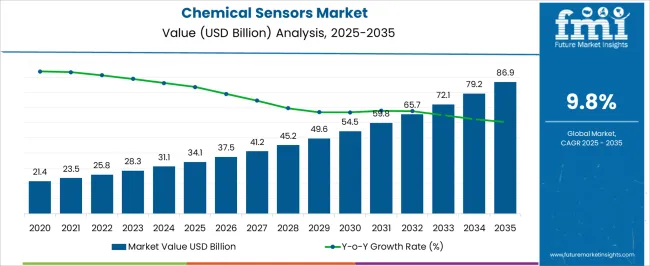
| Metric | Value |
|---|---|
| Chemical Sensors Market Estimated Value in (2025 E) | USD 34.1 billion |
| Chemical Sensors Market Forecast Value in (2035 F) | USD 86.9 billion |
| Forecast CAGR (2025 to 2035) | 9.8% |
The chemical sensors market is witnessing steady growth driven by increasing demand for monitoring and detection solutions across industrial, environmental, and healthcare sectors. The market is being shaped by advancements in sensor technology that enable higher sensitivity, rapid response, and real-time monitoring of chemical compounds. Growing industrial automation, rising safety regulations, and stricter environmental standards are encouraging the adoption of chemical sensors to ensure process control, occupational safety, and compliance.
Continuous innovation in miniaturized, flexible, and integrated sensor platforms is enhancing the usability and application potential of chemical sensors in diverse environments. Electrochemical, optical, and semiconductor-based sensor technologies are being deployed to detect gases, liquids, and chemical reactions with improved accuracy.
Rising investments in smart manufacturing and predictive maintenance strategies are further driving market adoption, while increasing awareness about environmental monitoring and hazardous gas detection supports long-term growth As industries seek cost-effective, reliable, and highly sensitive detection solutions, the chemical sensors market is expected to experience strong expansion over the coming decade, with technological innovation and regulatory compliance serving as key growth drivers.
The chemical sensors market is segmented by type, application, technology, end use, and geographic regions. By type, chemical sensors market is divided into Gas, Liquid, and Solid. In terms of application, chemical sensors market is classified into Industrial, Medical, Environmental Monitoring, Defence, and Homeland Security. Based on technology, chemical sensors market is segmented into Electrochemical, Biochemical, Optical, Electrical, Electromechanical, and Thermometric. By end use, chemical sensors market is segmented into Medical, Automotive, and Healthcare. Regionally, the chemical sensors industry is classified into North America, Latin America, Western Europe, Eastern Europe, Balkan & Baltic Countries, Russia & Belarus, Central Asia, East Asia, South Asia & Pacific, and the Middle East & Africa.
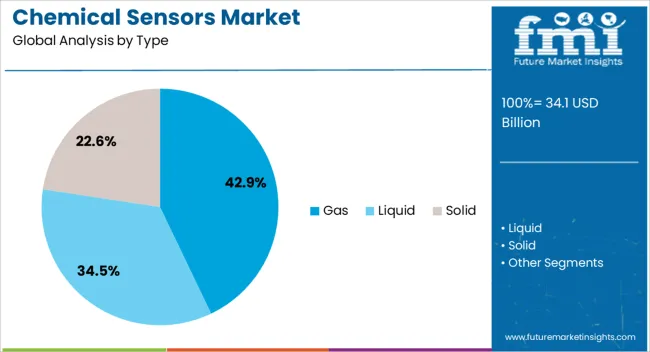
The gas sensor segment is projected to account for 42.9% of the chemical sensors market revenue share in 2025, making it the leading product type. Its leadership is being driven by the critical need for accurate and real-time detection of industrial gases, toxic emissions, and environmental pollutants.
Gas sensors are being widely adopted due to their ability to provide rapid response and continuous monitoring in industries such as oil and gas, chemical processing, and manufacturing, where safety and compliance are paramount. Technological advancements in miniaturization and sensor calibration have enhanced performance and reliability, enabling deployment in both fixed and portable systems.
The segment benefits from rising industrial automation and the integration of smart monitoring systems, which rely on gas detection for process optimization and hazard prevention Additionally, growing regulatory requirements for workplace safety and environmental protection are compelling organizations to implement gas sensors as standard monitoring solutions, reinforcing their market dominance.
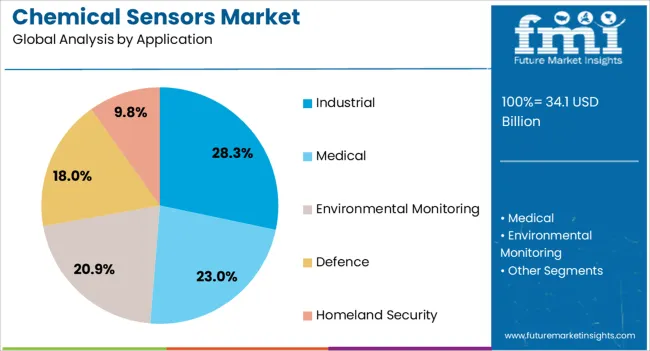
The industrial application segment is anticipated to hold 28.3% of the chemical sensors market revenue share in 2025, establishing itself as the leading application area. Its dominance is being driven by the rising need for continuous monitoring, process control, and safety compliance across manufacturing, chemical processing, and energy industries. Industrial chemical sensors are increasingly deployed to detect toxic gases, monitor chemical reactions, and optimize operational efficiency.
The segment is benefiting from the growing emphasis on workplace safety standards and environmental regulations, which require real-time monitoring of potentially hazardous substances. Adoption is also being supported by advancements in sensor integration with industrial automation systems, enabling predictive maintenance and process optimization.
The ability to provide accurate measurements under harsh industrial conditions enhances the reliability and utility of these sensors As industries continue to prioritize operational efficiency, safety, and environmental compliance, the industrial application segment is expected to maintain a leading position in the chemical sensors market.
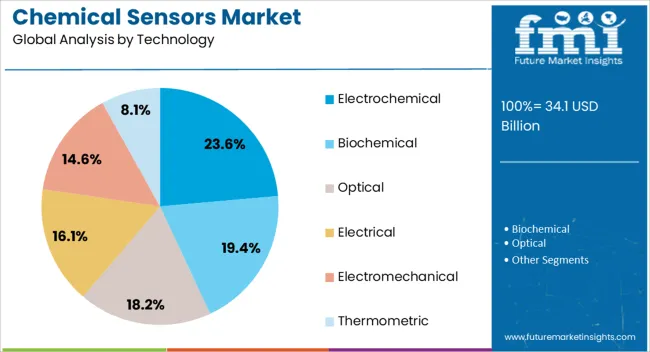
The electrochemical technology segment is expected to account for 23.6% of the chemical sensors market revenue share in 2025, securing its position as the leading technology category. Its dominance is being supported by high sensitivity, low detection limits, and rapid response capabilities, which make it suitable for detecting gases, volatile organic compounds, and various industrial chemicals. Electrochemical sensors offer advantages such as portability, low power consumption, and compatibility with both industrial and environmental monitoring systems.
The segment benefits from ongoing research and innovation in electrode materials and sensor design, which improve performance, longevity, and stability. Increasing adoption in industrial safety, environmental compliance, and healthcare monitoring applications is further driving market growth.
Regulatory requirements for precise chemical detection and workplace safety are accelerating the deployment of electrochemical sensors Their ability to provide reliable, real-time data for critical decision-making ensures continued preference among end users, reinforcing their leading share in the chemical sensors market.
“Chemical sensors will be in high demand in North America, owing to increase in vehicle production, increased research and development efforts, and the push to reduce pollution levels in the near future.”
North America and Europe are the leading regions in terms of overall demand for chemical sensors. Adoption of chemical sensors is expected to grow rapidly in APAC over the forecast period.
The APAC chemical sensors market is likely to emerge as the fastest growing market with a double-digit CAGR over the forecast period 2025-2025.
The concerning pollution levels in China, India and other APAC countries is also driving the demand for chemical sensors.
Low chemical sensors price, flexible applications and speedy technological implementations are fuelling the demand for chemical sensors in the APAC market.
The APAC chemical sensors market forecast seems promising, owing to the rising usage of chemical sensors in industrial safety operations and environmental monitoring programs.
“The chemical sensors market is expected to grow, due to rising demand for chemical sensors from the oil and gas and automotive industries.”
In APAC, chemical sensors can be termed as ideal components, having analytical functions, which can help prevent the unwanted output of several processes and monitor the health of the atmosphere.
The factors impelling the onward growth of APAC market for chemical sensors include,
The manifestation of advanced chemicals sensor technology for the production of cost-effective, miniaturised and lightweight chemical detector, capable of continuous and static measurements in the remote environment, is a latent growth factor in the APAC chemical sensors market.
On the other hand, the growth of chemical sensors market in APAC region is facing challenges that are derived from the resulting output of the use of chemical sensors. The three most crucial restraints of chemical sensors market include,
Chemical sensors are selective in nature. For example, biochemical sensors can be applied only in biochemical process, and their use in other processes can deliver inefficient output.
Upon continuous exposure to haphazard materials and chemicals, the sensitivity of the sensors will degrade. This will result in the persisting replacement of chemical sensors, and create a despise environment for the end-users.
The design of any chemical sensor makes it unidirectional. However, the reversible chemical reactions occurring in an industrial process may alter the monitoring function and thereby, regard the chemical sensors as useless.
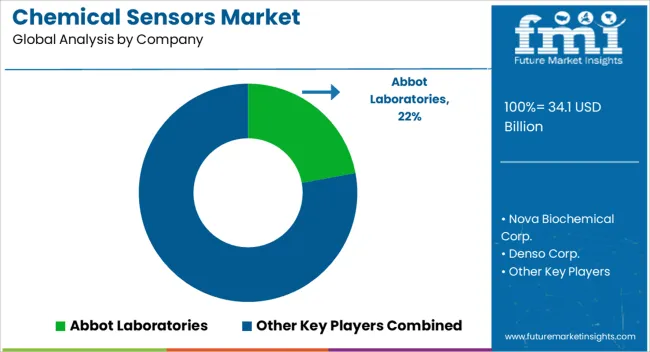
The key companies shaping up the competitive landscape of chemical sensors market, including APAC region, are Abbot Laboratories, Nova Biochemical Corp., Denso Corp., Hoffmann-La Roche, NGK Spark Plug Company, Emerson Process Management, among others.
In 2025, the leading multinational sensor and semiconductor manufacturer, Austria Mikro System (commonly known as ams AG) acquired the CMOS sensors from NXP Semiconductors as a strategic measure to expand their existing environmental sensor technologies. Mergers as such illustrate the expansion of the chemical sensors market size.
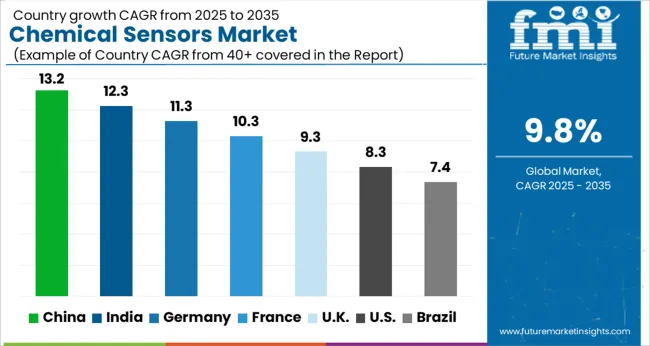
| Country | CAGR |
|---|---|
| China | 13.2% |
| India | 12.3% |
| Germany | 11.3% |
| France | 10.3% |
| UK | 9.3% |
| USA | 8.3% |
| Brazil | 7.4% |
The Chemical Sensors Market is expected to register a CAGR of 9.8% during the forecast period, exhibiting varied country level momentum. China leads with the highest CAGR of 13.2%, followed by India at 12.3%. Developed markets such as Germany, France, and the UK continue to expand steadily, while the USA is likely to grow at consistent rates. Brazil posts the lowest CAGR at 7.4%, yet still underscores a broadly positive trajectory for the global Chemical Sensors Market. In 2024, Germany held a dominant revenue in the Western Europe market and is expected to grow with a CAGR of 11.3%. The USA Chemical Sensors Market is estimated to be valued at USD 11.8 billion in 2025 and is anticipated to reach a valuation of USD 26.2 billion by 2035. Sales are projected to rise at a CAGR of 8.3% over the forecast period between 2025 and 2035. While Japan and South Korea markets are estimated to be valued at USD 1.6 billion and USD 979.7 million respectively in 2025.
| Item | Value |
|---|---|
| Quantitative Units | USD 34.1 Billion |
| Type | Gas, Liquid, and Solid |
| Application | Industrial, Medical, Environmental Monitoring, Defence, and Homeland Security |
| Technology | Electrochemical, Biochemical, Optical, Electrical, Electromechanical, and Thermometric |
| End Use | Medical, Automotive, and Healthcare |
| Regions Covered | North America, Europe, Asia-Pacific, Latin America, Middle East & Africa |
| Country Covered | United States, Canada, Germany, France, United Kingdom, China, Japan, India, Brazil, South Africa |
| Key Companies Profiled | Abbot Laboratories, Nova Biochemical Corp., Denso Corp., Hoffmann-La Roche, NGK Spark Plug Company, and Emerson Process Management |
The global chemical sensors market is estimated to be valued at USD 34.1 billion in 2025.
The market size for the chemical sensors market is projected to reach USD 86.9 billion by 2035.
The chemical sensors market is expected to grow at a 9.8% CAGR between 2025 and 2035.
The key product types in chemical sensors market are gas, liquid and solid.
In terms of application, industrial segment to command 28.3% share in the chemical sensors market in 2025.






Our Research Products

The "Full Research Suite" delivers actionable market intel, deep dives on markets or technologies, so clients act faster, cut risk, and unlock growth.

The Leaderboard benchmarks and ranks top vendors, classifying them as Established Leaders, Leading Challengers, or Disruptors & Challengers.

Locates where complements amplify value and substitutes erode it, forecasting net impact by horizon

We deliver granular, decision-grade intel: market sizing, 5-year forecasts, pricing, adoption, usage, revenue, and operational KPIs—plus competitor tracking, regulation, and value chains—across 60 countries broadly.

Spot the shifts before they hit your P&L. We track inflection points, adoption curves, pricing moves, and ecosystem plays to show where demand is heading, why it is changing, and what to do next across high-growth markets and disruptive tech

Real-time reads of user behavior. We track shifting priorities, perceptions of today’s and next-gen services, and provider experience, then pace how fast tech moves from trial to adoption, blending buyer, consumer, and channel inputs with social signals (#WhySwitch, #UX).

Partner with our analyst team to build a custom report designed around your business priorities. From analysing market trends to assessing competitors or crafting bespoke datasets, we tailor insights to your needs.
Supplier Intelligence
Discovery & Profiling
Capacity & Footprint
Performance & Risk
Compliance & Governance
Commercial Readiness
Who Supplies Whom
Scorecards & Shortlists
Playbooks & Docs
Category Intelligence
Definition & Scope
Demand & Use Cases
Cost Drivers
Market Structure
Supply Chain Map
Trade & Policy
Operating Norms
Deliverables
Buyer Intelligence
Account Basics
Spend & Scope
Procurement Model
Vendor Requirements
Terms & Policies
Entry Strategy
Pain Points & Triggers
Outputs
Pricing Analysis
Benchmarks
Trends
Should-Cost
Indexation
Landed Cost
Commercial Terms
Deliverables
Brand Analysis
Positioning & Value Prop
Share & Presence
Customer Evidence
Go-to-Market
Digital & Reputation
Compliance & Trust
KPIs & Gaps
Outputs
Full Research Suite comprises of:
Market outlook & trends analysis
Interviews & case studies
Strategic recommendations
Vendor profiles & capabilities analysis
5-year forecasts
8 regions and 60+ country-level data splits
Market segment data splits
12 months of continuous data updates
DELIVERED AS:
PDF EXCEL ONLINE
Pellistor Bead Chemical Sensors Industry Analysis by Component, End-Use Industry, and Region through 2035
Chemical Hydraulic Valves Market Size and Share Forecast Outlook 2025 to 2035
Chemical Vapor Deposition Market Forecast Outlook 2025 to 2035
Chemical Recycling Service Market Forecast Outlook 2025 to 2035
Chemical Dosing Equipment Market Size and Share Forecast Outlook 2025 to 2035
Chemical Filling System Market Size and Share Forecast Outlook 2025 to 2035
Chemical Absorbent Pads Market Size and Share Forecast Outlook 2025 to 2035
Chemical Indicator Inks Market Size and Share Forecast Outlook 2025 to 2035
Chemical Boiler Market Size and Share Forecast Outlook 2025 to 2035
Chemical Hardener Compounds Market Size and Share Forecast Outlook 2025 to 2035
Chemical Anchors Market Size and Share Forecast Outlook 2025 to 2035
Chemical Peel Market Size and Share Forecast Outlook 2025 to 2035
Chemical Protective Gloves Market Size and Share Forecast Outlook 2025 to 2035
Chemical Injection Pump Market Size and Share Forecast Outlook 2025 to 2035
Chemical Liquid Hydrogen Market Size and Share Forecast Outlook 2025 to 2035
Chemical Resistant EVA Film Market Size and Share Forecast Outlook 2025 to 2035
Chemical Resistant Fabrics Market Size and Share Forecast Outlook 2025 to 2035
Chemical Resistant Coating Market Size and Share Forecast Outlook 2025 to 2035
Chemical Distribution Market Size and Share Forecast Outlook 2025 to 2035
Chemical & Petrochemical IECS Market Size and Share Forecast Outlook 2025 to 2035

Thank you!
You will receive an email from our Business Development Manager. Please be sure to check your SPAM/JUNK folder too.
Chat With
MaRIA